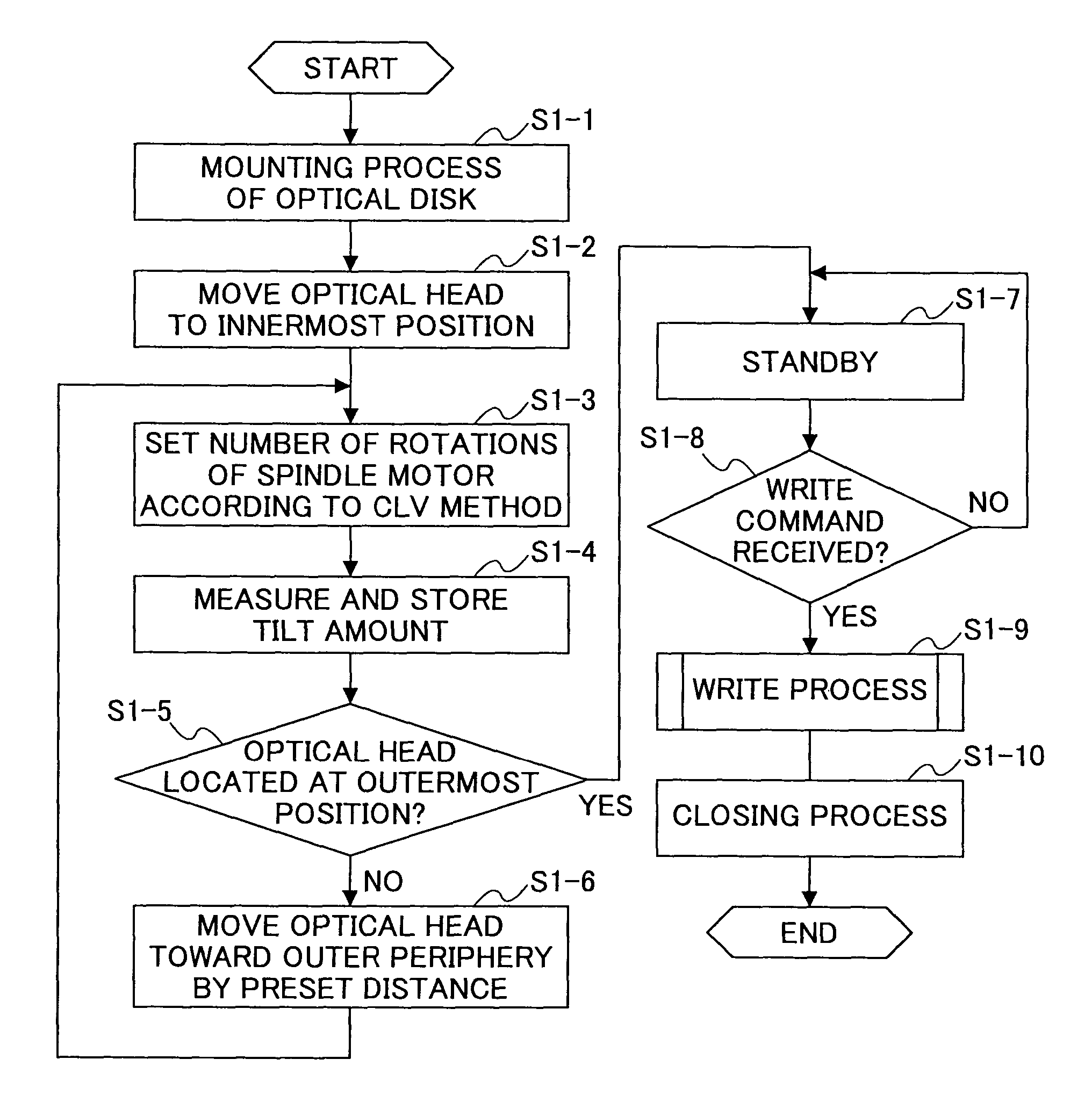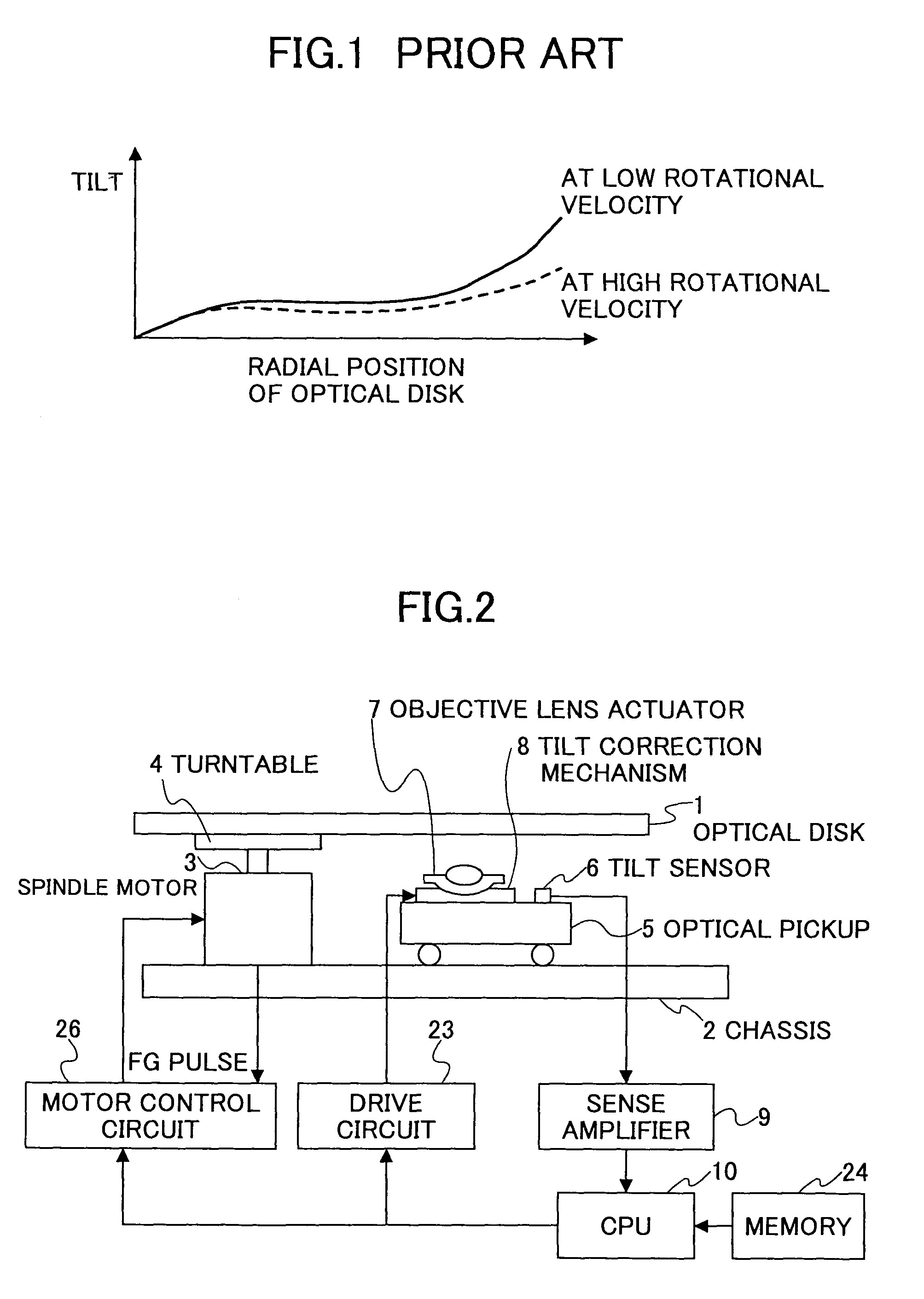Tilt correction method detecting tilt with same linear velocity as upon actually recording/reproducing at each radial position
a correction method and tilt technology, applied in the direction of digital signal error detection/correction, instruments, recording signal processing, etc., can solve the problems of imposing a negative influence on recording/reproducing quality, deteriorating recording/reproduction quality, and troublesome recording/reproduction
- Summary
- Abstract
- Description
- Claims
- Application Information
AI Technical Summary
Benefits of technology
Problems solved by technology
Method used
Image
Examples
example 1
[0072]When the write command is received, the optical head is first moved to a write start position (S2-1) as shown in FIG. 7. Thereafter, a tilt amount at a tilt-amount measuring position nearest the write start position is read from the memory 24, and a tilt correction is performed according to the read tilt amount (S2-2), and thereafter, a recording is started (S2-3). During the recording, the position of the optical head is monitored (S2-4). When the optical head reaches the next tilt-amount measuring position (Y in S2-4), a tilt correction amount corresponding to the tilt-amount measuring position is read from the memory 24, and a tilt correction is performed according to the read tilt amount (S2-5). Then, when the recording is completed (Y in S2-6), the closing process follows the write process.
example 2
[0073]When the write command is received, the optical head is first moved to a write start position (S3-1) as shown in FIG. 8. Thereafter, a tilt amount at a tilt-amount measuring position nearest the write start position is read from the memory 24, and a tilt correction is performed according to the read tilt amount (S3-2), and thereafter, a recording is started (S3-3). During the recording, the position of the optical head is monitored. S3-1 to S3-3 in Example 2 are identical to S2-1 to S2-3 in Example 1. Then, it is judged whether the optical head reaches a middle point to the next tilt-amount measuring position (S3-4). When the optical head reaches the middle point (Y in S3-4), a tilt correction amount corresponding to the next tilt-amount measuring position is read from the memory 24, and a tilt correction is performed according to the read tilt amount (S3-5). Then, when the recording is completed (Y in S3-6), the closing process follows the write process.
example 3
[0074]When the write command is received, the optical head is first moved to a write start position (S4-1) as shown in FIG. 9. Thereafter, it is judged whether the present position of the optical head is a tilt-amount measuring position (S4-2). When the present position of the optical head is a tilt-amount measuring position (Y in S4-2), a tilt amount corresponding to the present position is read from the memory 24, and a tilt correction is performed according to the read tilt amount (S4-3). When the present position of the optical head is not a tilt-amount measuring position (N in S4-2), tilt amounts corresponding to tilt-amount measuring positions adjacent to the present position both inwardly and outwardly are read from the memory 24, and a tilt amount of the present position is calculated by a proportional calculation, and then, a tilt correction is performed according to the calculated tilt amount (S4-4).
[0075]Thus, after performing the tilt correction at the write start positi...
PUM
 Login to View More
Login to View More Abstract
Description
Claims
Application Information
 Login to View More
Login to View More - R&D
- Intellectual Property
- Life Sciences
- Materials
- Tech Scout
- Unparalleled Data Quality
- Higher Quality Content
- 60% Fewer Hallucinations
Browse by: Latest US Patents, China's latest patents, Technical Efficacy Thesaurus, Application Domain, Technology Topic, Popular Technical Reports.
© 2025 PatSnap. All rights reserved.Legal|Privacy policy|Modern Slavery Act Transparency Statement|Sitemap|About US| Contact US: help@patsnap.com



